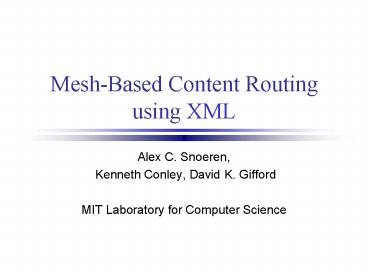Mesh-Based Content Routing using XML PowerPoint PPT Presentation
Title: Mesh-Based Content Routing using XML
1
Mesh-Based Content Routing using XML
- Alex C. Snoeren,
- Kenneth Conley, David K. Gifford
- MIT Laboratory for Computer Science
2
The Goal
- Reliably serve time-critical data streams
- To clients interested in different content
- Over a failure-prone and lossy Internet
3
Air Traffic Control Data
- Different client requests
- United Airlines flights
- Flights below 30,000 feet
- Takeoffs landings at BOS
- Time-critical data
- Lost or delayed data can be catastrophic
- Other domains have similar demands
- Sensor networks, live multimedia, etc.
4
Pub/Sub XML Style
- Servers generate an XML stream
- Annotate each XML packet individually
- Clients provide XML queries
- Parsing and query application is schema agnostic
- Network prunes content appropriately
- Internal nodes perform stream erasure to remove
unwanted stream elements - Application-level queries can be pushed into the
network and combined
5
XML Encoding
- 153014022245CCZVTZ UAL1021 512 290 4928N12003W
- lt?xml version1.0?gt
- ltmessageidgt153014022245CCZVTZlt/messageidgt
- ltflightgt
- ltidgtUAL1021lt/idgt
- ltflightleg statusactivegt
- ltspeed type groundgt512lt/speedgt
- ltaltitude type reported mode
plaingt290lt/altitudegt - ltcoordinategtltlatgt4928Nlt/latgtltlongt12003Wlt/longtlt/c
oordinategt - lt/flightleggt
- lt/flightgt
Only United flights starts-with(string(/flight/id
),UA Flights below 30,000ft /flight/flightleg/a
ltitudelt300
6
XML Router Architecture
- Input DCP component
- Maintain parent set
- Assemble data stream
- XML Switch
- Parse incoming XML stream
- Route XML packets based on link queries
- Output DCP component
- Manage client subscriptions
- Package and distribute XML streams to clients
7
Coping with Failure
- Can handle node or link failure in two ways
- Component repair or replacement
- Takes time to detect failure and identify
replacement - Synchronizing replacement takes additional time
- Node and link redundancy
- Additional resources may need to be reserved
- Keeping standbys synchronized adds overhead
- Conclusion Use hot standbys, but
- Make effective use of existing resources
- Derive improved performance in the general case
8
Mesh-Based Routing
9
N-Resilient Mesh Construction
- Need to satisfy only three requirements
- Each node needs (n1) distinct parents
- Mesh must always be acyclic
- Paths to parents should be distinct
- Can be reconfigured on-line
- Nodes dynamically adjust their position
- By moving across or higher up
- Allows performance tuning
- Requirements may not be known a priori
10
Mesh Tuning
11
Dealing with Loss
- Can handle data loss in two ways
- Data retransmission (ARQ)
- Adds latency for NACK and subsequent
retransmission - Fact Internet latency is physically bounded from
below - Data redundancy (FEC)
- Reduces available bandwidth due to extra data
- Fact Number and capacity of Internet links is
increasing - Conclusion Send redundant data, but
- When it is likely to be most useful, and
- Where it will be most effective
12
Redundant coding
- Effectiveness of single-path FEC is limited
- Routing failures heal slowly Labovitz 00
- Packet loss is bursty Bolot 93, Paxson 99
- Use erasure coding across paths
- Erasure codes enable efficient encodings, but
- High efficiency requires large numbers of packets
- Decoding requiring multiple packets increases
latency - Carousel-based techniques add delay
- Duplicate packets can actually decrease latency
- But may not be as bandwidth efficient
- Hop-by-hop retransmission decreases recovery time
13
Diversity Control Protocol
- Combines data from multiple sources
- Packets given appl. seq. nos. (ANs) by root nodes
- Uses first copy of each packet received
- Detects packet loss
- Each packet includes previous packet AN
- NACK-based retransmits
- Enables stream erasure
- Modify previous AN field
14
Emperical Loss Independence
0.1
Dispersity Routing
(Bottlenecked Hosts)
Back-to-Back
0.08
0.06
Effective loss rate
0.04
0.02
0
0
0.02
0.04
0.06
0.08
0.1
Observed packet loss rate
15
Reduced Latency
16
Summary
- Content-Based XML streaming
- Each packet is its own XML document
- Network is schema agnostic
- Diversity Control Protocol
- Reassembles stream from multiple sources
- Allows stream erasure while detecting loss
- Mesh-based overlay routing
- Provides tunable resilience to failure loss
- Can improve performance in general case

